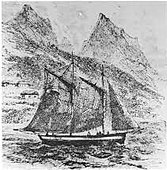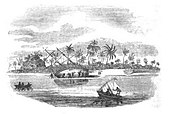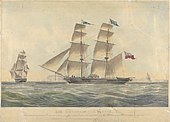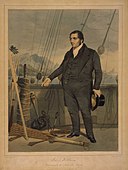
John Williams was an English missionary, active in the South Pacific. Born at Tottenham, near London, England, he was trained as a foundry worker and mechanic.
Parmelia was a barque built in Quebec, Canada, in 1825. Originally registered on 31 May in Quebec, she sailed to Great Britain and assumed British registry. She made one voyage for the British East India Company (EIC), in 1827-1828. In 1829 she transported the first civilian officials and settlers of the Swan River Colony to Western Australia. She then made two voyages transporting convicts to New South Wales, Australia. A fire damaged her irreparably in May 1839.

The London Missionary Society was a predominantly Congregationalist missionary society formed in England in 1795 at the instigation of Welsh Congregationalist minister Dr Edward Williams working with evangelical Anglicans and various nonconformists. It was largely Reformed in outlook, with Congregational missions in Oceania, Africa, and the Americas, although there were also Presbyterians, Methodists, Baptists and various other Protestants involved. It now forms part of the Council for World Mission (CWM).

Aaron Buzacott the elder, a Congregationalist colleague of John Williams, author of ethnographic works and co-translator of the Bible into the language of Rarotonga, was a central figure in the South Seas missionary work of the London Missionary Society, living on Rarotonga between 1828 and 1857.

James Chalmers was a Scottish-born missionary, active in New Guinea.

Reverend Carl Wilhelm Schmidt, also known as Karl Schmidt, was a German missionary, and an ordained minister of the Prussian United Church. Schmidt's missionary work took him to Queensland and Samoa, where he founded a number of Lutheran institutions and settlements.

Robert Clark Morgan was an English sea captain, whaler, diarist, and, in later life, a missionary. He captained the Duke of York, bringing the first settlers to South Australia in 1836. His life in the British whaling industry has been recorded in the book The Man Who Hunted Whales (2011) by Dorothy M. Heinrich. His diaries are held in the State Library of New South Wales.
Duke of York was a three-masted brig launched in 1817 at Bideford as a Falmouth packet, sailing between Falmouth, Cornwall, and Jamaica. In 1836 she brought settlers to South Australia for the South Australia Company. She was wrecked in 1837.

William Wyatt Gill was an English missionary, active in Australia and the South Pacific region after 1851.

Captain John Dibbs, (1790–1872) was a master mariner prominent during 1822–1835 in the seas around the colony of New South Wales, New Zealand and the Society Islands. Dibbs was master of the colonial schooner Endeavour 1822–1824, the brig Haweis 1824–1827 and the barque Lady Blackwood 1827–1834. He is credited as the European discoverer of Rarotonga and several other islands. Most of his voyages involved the transporting of missionaries, trade, whaling and seal hunting. He was believed for over 170 years to have disappeared at sea in 1835. He was the father of Sir George Dibbs, a pre-Federation Australian politician, Sir Thomas Dibbs, an Australian banker, and John Campbell Dibbs, a successful Sydney businessman.

Pa Maretu Ariki was a sovereign of the Cook Islands. He was the ariki of the Pa dynasty, one of the two chiefdoms of the Takitumu tribe on the island of Rarotonga.

John Geddie was a Scots-Canadian missionary who was known as "the father of Presbyterian missions in the South Seas." He pioneered missionary work in the New Hebrides islands, now known as Vanuatu. He became Doctor of Divinity in 1866. On December 14, 1872 he died in Geelong, Australia.
Bible translations into Oceanic languages have a relatively closely related and recent history.

Pitcairn was a schooner built in 1890 for the Seventh-day Adventist Church for use in missionary work in the South Pacific. After six missionary voyages, the schooner was sold in 1900 for commercial use, and renamed Florence S. She was lost by stranding on the island of Mindoro, Philippine Islands, on 17 October 1912.
HMS Nimrod was a brig-sloop of the British Royal Navy, launched in 1812. She spent her war years in north American waters where she captured one small privateer, assisted in the capture of another, and captured or destroyed some 50 American vessels. After the war she captured smugglers and assisted the civil authorities in maintaining order in Tyne. She was wrecked in 1827 and so damaged that the Navy decided she was not worth repairing. A private ship-owner purchased Nimrod and repaired her. She then went on to spend some 20 years trading between Britain and Charleston, the Mediterranean, Australia, and India. She was last listed in 1851.
Emma was a merchant vessel launched at Calcutta in 1809 that served as a government armed ship in the British invasion of Île de France in 1810. In 1811 she sailed to England where she was sold. She then became a transport and later a whaler. Between 1815 and 1853 she made 11 whaling voyages. She was then sold and became a merchantman on the England-Australia run. Between 1851 and 1853 she made one more whaling voyage to the South Seas fisheries. She then returned to the England-Australia trade. In 1857 her home port became Hull, and she became a Greenland whaler, though that role may have begun as early as 1855. She was converted in 1864 to a screw steamer but was lost in April while sealing.
Brixton was built in the United States of America in 1802, with sources disagreeing on where, and under a different name. The British Royal Navy seized her in 1805 and she was sold in prize. She then traded widely, sailing to the West Indies, Canada, Bengal, Australia, and Russia. Between 1835 and 1842 she made two voyages to the British Southern Whale Fishery as a whaling ship, and was last listed in 1842.

Marumaru Atua is a reconstruction of a vaka moana, a double-hulled Polynesian voyaging canoe. It was built in 2009 by the Okeanos Foundation for the Sea. In 2014, it was gifted to the Cook Islands Voyaging Society. It is used to teach polynesian navigation.

Papeiha was an evangelist of the London Missionary Society. Trained by John Williams, he converted the islands of Aitutaki and Rarotonga in the Cook Islands to Christianity.



















